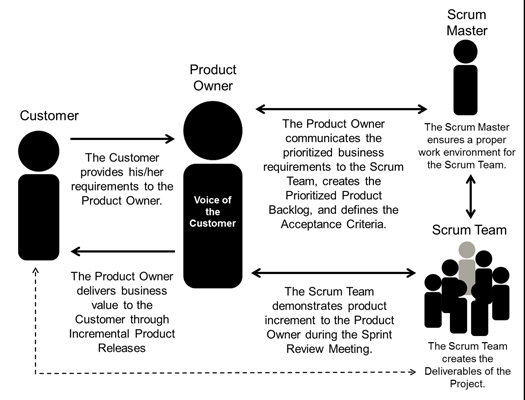Understanding defined roles and responsibilities in a Scrum project is very important for ensuring successful implementation of Scrum.
Scrum roles fall into two broad categories
- Core Roles - Core roles are those roles which are mandatorily required for producing the project's product or service. Individuals who are assigned core roles are fully committed to the project and are ultimately responsible for the success of each project iteration and of the project as a whole.
These roles include:
- The Product Owner is the person responsible for achieving maximum business value for the project. He or she is also responsible for articulating customer requirements and maintaining business justification for the project. The Product Owner represents the Voice of the Customer.
- The Scrum Master is a facilitator who ensures that the Scrum Team is provided with an environment conducive to completing the project successfully. The Scrum Master guides, facilitates, and teaches Scrum practices to everyone involved in the project; clears impediments for the team; and, ensures that Scrum processes are being followed.
- The Scrum Team is the group or team of people who are responsible for understanding the requirements specified by the Product Owner and creating the Deliverables of the project.
- Non-core Roles - Non-core roles are those roles which are not mandatorily required for the Scrum project and may include team members who are interested in the project. They have no formal role in the project team and may interface with the team, but may not be responsible for the success of the project. The non-core roles should be taken into account in any Scrum project.
Non-core roles include the following:
- Stakeholder(s), which is a collective term that includes customers, users, and sponsors, frequently interface with the Scrum Core Team, and influence the project throughout the project's development. Most importantly, it is for the stakeholders that the project produces the collaborative benefits.
- Scrum Guidance Body (SGB) is an optional role, which generally consists of a set of documents and/or a group of experts who are typically involved with defining objectives related to quality, government regulations, security, and other key organizational parameters. This SGB guides the work carried out by the Product Owner, Scrum Master, and Scrum Team.
- Vendors, including external individuals or organizations provide products and/or services that are not within the core competencies of the project organization.
- Chief Product Owner is a role in bigger projects with multiple Scrum Teams. This role is responsible for facilitating the work of multiple Product Owners, and maintaining business justification for the larger project.
- Chief Scrum Master is responsible to coordinate Scrum-related activities in large projects which may require multiple Scrum Teams to work in parallel.
Following figure illustrates the Scrum organization structure:

